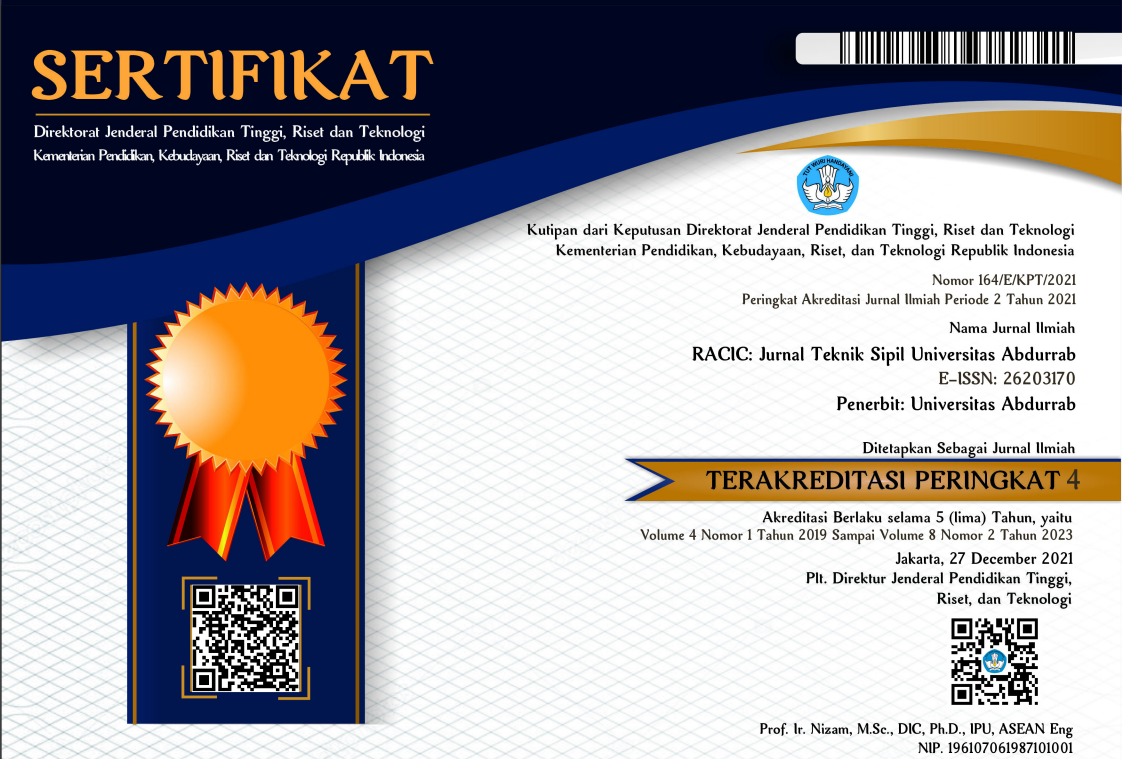PERENCANAAN ULANG PERKUATAN STRUKTUR DERMAGA MENGGUNAKAN PONDASI TIANG PANCANG DENGAN VARIASI DIAMETER
DOI:
https://doi.org/10.36341/racic.v8i1.3099Keywords:
Variation Diameter, Carrying Capacity, SettlementAbstract
The wharf is one of the supporting facilities for the process of loading and unloading goods on ships. For services for long-term ships and loads caused by the process of loading and unloading ships, the safety of the wharf needs to be improved by strengthening the foundation. Berlian Pier uses a steel pile foundation with a diameter of 1.016 m and a length of 32 m. This study used the Meyerhoff method to calculate the bearing capacity of the piles and N-SPT data for the Reinforcement of Wharf Structures Using Diameter Variations at Berlian Surabaya Pier. Based on the re-planning that has been done, it is concluded that a diameter of 1.00 m and a length of 32 m obtains a single pile bearing capacity of 8164 Tons, shear resistance of 28120.4 Tons, axial bearing capacity of 8345.42 Tons. Immediate settlement of 38.551 mm, annual settlement of 00,0201 mm, long-term settlement of 0,193 mm, and total settlement of 48,050 mm.
Keywords: Variation Diameter, Carrying Capacity, Settlement
Downloads
References
Bambang Triatmodjo (2009) ‘Perencanaan Pelabuhan’, Beta Offset Yoygakarta, 1999(December), pp. 1–6.
Budiartha, R.M.N. (2016) Pelabuhan : Perencanaan dan Perancangan Konstruksi Bangunan Laut dan Pantai Nyoman.
Hardiyatmo, H.C. (2008) ‘Teknik Fondasi 2’, Gramedia Pustaka Utama, p. 275. Available at: https://www.academia.edu/download/57492139/Hardiyatmo______-_1996_-_Teknik_Pondasi_1.pdf.
Downloads
Published
Issue
Section
License
1. Copyright of all journal manuscripts is held by the RACIC : Rab Construction Research
2. Formal legal provisions to access digital articles of electronic journal are subject to the provision of the Creative Commons Attribution-ShareAlike license (CC BY-NC-SA), which means that RACIC : Rab Construction Research is rightful to keep, transfer media/format, manage in the form of databases, maintain, and publish articles.
3. Published manuscripts both printed and electronic are open access for educational, research, and library purposes. Additionally, the editorial board is not responsible for any violations of copyright law.
licensed under a Creative Commons Attribution-ShareAlike 4.0 International License.





